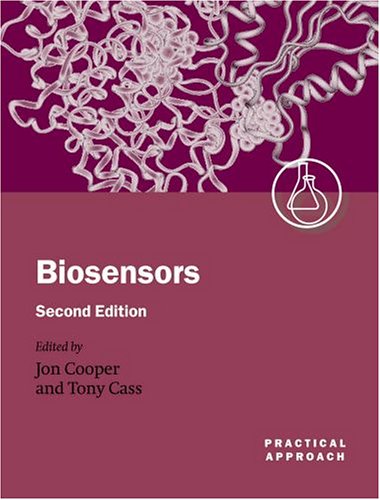Jon Cooper, Tony Cass0199638462, 0199638454, 9780199638468, 9780199638451
Table of contents :
0199638454……Page 1
Front Matter……Page 2
Protocol List……Page 4
Abbreviations……Page 6
Contributors……Page 8
Preface……Page 10
Table of Contents……Page 12
1.1.1 Relationship to Mediator-Based Sensors……Page 16
1.1.3 Dependence of the Diffusivity of Electrons on Crosslinking and the Advantage of Composite Electrodes……Page 17
1.1.4 The Redox Polymers and Their Electrochemistry……Page 18
1.2.1 Electron Transfer between Enzyme and Polymer Redox Centers……Page 19
1.2.3 Optimal Compositions……Page 21
1.3.1 Amperometric and Potentiometric Biosensors of Substrates of “Wired” Redox Enzymes……Page 22
1.3.2 Sensor Measuring the Turnover Rate of Hydrolytic and other Non-Redox Enzymes……Page 23
1.3.4 Affinity Sensors……Page 25
References……Page 26
2.1 Introduction……Page 34
2.2 Function of Oligonucleotide Sensitive Electrodes……Page 35
2.3 Hybridization Efficiency and Sensitivity……Page 36
2.4.1 Surface Concentration……Page 37
2.4.2 Probe Length and Orientation……Page 38
2.4.3 Attachment of Probe……Page 40
2.4.3.2 Non-Covalent or Physisorption……Page 42
2.4.3.4 Deposition onto a Polymer Coated Electrode……Page 43
2.5 Hybridization Conditions……Page 45
2.5.1 Temperature……Page 46
2.5.2 Ionic Strength……Page 47
2.5.3 Base Mismatch……Page 48
2.5.5 Nonspecific Adsorption……Page 49
2.6 Hybridization Kinetics……Page 51
References……Page 53
3.1 Introduction……Page 55
3.2.1.1 Substrate Matrix……Page 56
3.2.1.2 Inks……Page 57
3.2.1.3 Sensing Element……Page 58
3.2.2 Apparatus……Page 61
3.2.3 Printing Patterns……Page 62
3.2.4 Printing Process……Page 63
3.3.1 Clinical Diagnosis……Page 65
3.3.3 Environmental Monitoring……Page 66
3.3.4 Other Approaches……Page 68
References……Page 69
4.1.1 The Purpose and Practice of Modeling……Page 73
4.1.2.2 Michaelis-Menten Kinetics……Page 74
4.1.2.3 Analysis of Enzyme Kinetic Data……Page 76
4.1.3.1 Mass Transport……Page 77
4.1.3.2 Fick’s First Law……Page 78
4.1.3.3 Fick’s Second Law……Page 80
4.1.3.4 Coupled Chemical Reaction……Page 82
4.2 Modeling……Page 83
4.2.2 Simplifying Assumptions……Page 84
4.2.3 The Flux Equations……Page 85
4.2.4.1 The Advantages of Using Reciprocal Expressions……Page 87
4.2.4.2 Solving the Coupled Diffusion/Reaction Problem……Page 88
4.2.5 Deriving a Complete Kinetic Model……Page 92
4.2.5.1 Case Diagrams……Page 93
4.2.6 Experimental Verification of Approximate Analytical Kinetic Models……Page 95
4.2.7.1 Explicit Numerical Methods……Page 96
4.2.7.2 The Crank-Nicholson Method……Page 99
4.2.7.3 Other Simulation Methods……Page 100
4.4 Kinetic Modeling in other Types of Biosensors……Page 103
4.4.2 Optical and Photometric Biosensors……Page 104
4.4.3 Immunosensors……Page 105
List of Symbols……Page 106
References……Page 108
5.2.1.1 Glass Fiber-Optic Bundle……Page 111
5.2.2.2 Measurements in a Flow System……Page 112
5.2.3.1 Bioluminescence……Page 114
5.2.4.1 Immobilization Techniques……Page 115
5.2.4.1.2 Enzyme Immobilization on Preactivated Polyamide Membranes……Page 116
5.2.4.1.3 Immobilization of “His-Tag” Enzymes……Page 117
5.3.3 Extension to other Analytes Using Dehydrogenases as Auxiliary Enzymes……Page 119
5.3.4 H_2O_2 Determination……Page 120
5.3.5.2 Using Oxidases as Auxiliary Enzymes……Page 121
References……Page 122
6.1.1 Why Fluorescence Anisotropy to Determine Metal Ions?……Page 123
6.2.1 “Reagent” Approaches……Page 125
6.2.2 “Reagentless” Approach……Page 126
6.3 Fluorescent Aryl Sulfonamides for Zinc(II) Determination……Page 128
6.4 Removal of Zinc from Carbonic Anhydrase (CA)……Page 129
6.5 Avoidance of Metal Ion Contamination……Page 131
6.6 Determination of Zn Using a Reagent Approach……Page 133
6.7 Determination of Cu and other Ions by Using a Reagentless Approach……Page 137
6.8 Calibration of Anisotropy……Page 138
Acknowledgments……Page 142
References……Page 143
7.1 Introduction……Page 145
7.1.1 Fiber Polishing……Page 147
7.2.1 Enzymatic Sensing Layer……Page 148
7.2.2 PAN Gel Immobilization……Page 149
7.3.1 Immobilization via Polymer Photodeposition……Page 150
7.3.2 Microwell Array Platform Preparation……Page 152
7.3.2.1 Microsphere Array Fabrication and Encoding……Page 153
7.3.2.2.1 Physical Adsorption……Page 155
7.3.2.2.2 Covalent Immobilization……Page 156
7.3.2.3 DNA Detection and Sequence Analysis……Page 158
7.3.3 Live-Cell Array Fabrication……Page 160
7.3.3.1 Cell Encoding……Page 161
7.3.3.3 Cell Viability……Page 162
References……Page 165
8.1 Introduction……Page 167
8.2.1 Concept of Patch Clamp on a Chip……Page 168
8.2.2.1 Chip Fabrication and Pretreatment……Page 171
8.2.2.2 Formation of Giant Unilamellar Vesicles……Page 175
8.2.2.4 Automated Seal Formation……Page 176
8.2.3 Chip-Based Planar Bilayers: Single-Channel Measurements of Alamethicin Pores……Page 179
8.3.1 Basics of Impedance Spectroscopy……Page 182
8.3.3.1 Description……Page 184
8.3.3.2 Impedance Spectroscopy Data……Page 186
8.3.4.1 Description……Page 188
8.3.4.2 Impedance Spectroscopy Data……Page 190
8.3.5.1 Description……Page 191
8.3.6.1 Description……Page 193
8.3.6.2 Impedance Spectroscopy Data……Page 194
References……Page 196
9.1 Introduction……Page 199
9.2 Rational Protein Engineering……Page 201
9.2.1 Modeling and Calculations on Protein Structures……Page 202
9.2.2 Site-Directed Mutagenesis……Page 213
9.2.2.1 Kunkel Method……Page 215
9.2.2.3 PCR Methods……Page 216
9.2.2.3.1 PCR Megaprimer Method……Page 226
9.2.2.3.2 QuikChange® PCR Method……Page 0
9.3 Directed Evolution……Page 236
9.3.1 Random Mutagenesis: Error Prone PCR……Page 238
9.3.2 Recombination: DNA Shuffling……Page 240
9.3.3 Functional Screening of the Library……Page 244
9.5 Other Aspects of Protein Engineering……Page 248
9.6 Concluding Remarks……Page 252
References……Page 253
A……Page 255
B……Page 256
C……Page 258
D……Page 261
E……Page 263
F……Page 265
G……Page 269
H……Page 270
I……Page 272
K……Page 273
L……Page 274
M……Page 275
N……Page 278
O……Page 279
P……Page 280
R……Page 284
S……Page 286
T……Page 290
U……Page 291
X……Page 292
Z……Page 293

Reviews
There are no reviews yet.